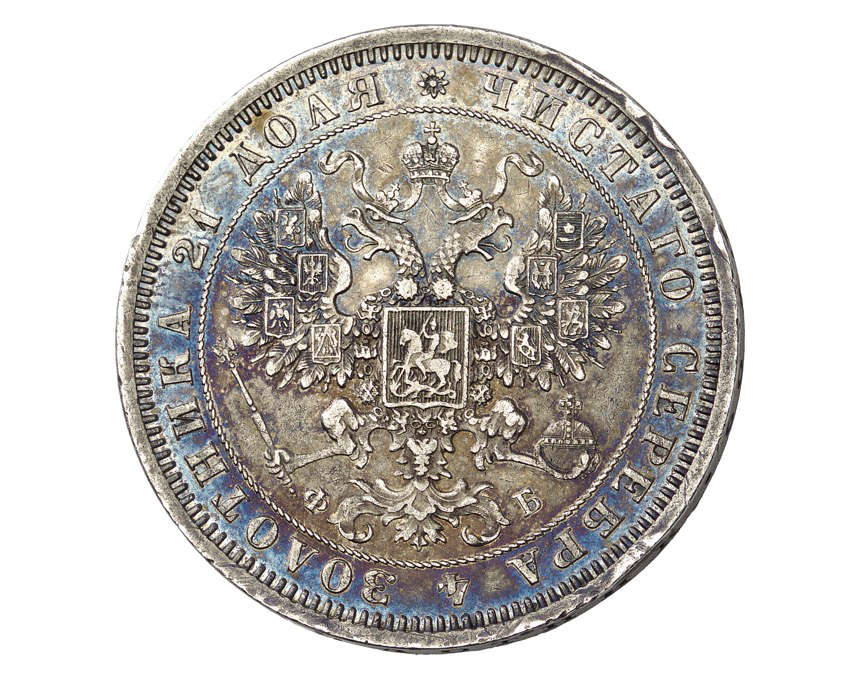A Total Result of 9.35M Euros for Künker’s Spring Auction Sales
Künker
Auction 403-406
Coins
18-22 March 2024
D-Osnabrück
Four catalogs, many special collections, a packed auction room and bidders from all over the world: Do you need anything more to guarantee the success of an auction sale? You certainly do not – which is why the Künker auction house in Osnabrück could once again experience a highly successful auction week. And ‘auction week’ is actually an understatement. Auction 402 with ancient coins, including the Sayar Collection, was sold as early as from 14 to 15 March 2024. We presented the results in a separate review. Coins from medieval and modern times followed from 18 to 22 March 2024. After a short break during the weekend, the auction week was rounded off on 26 March 2024 with eLive Premium Auction 407, featuring the Tursky Collection with coins of Emperor Franz Josef.
Catalog 403: Coins and Medals of the Popes
The auction week began with catalog 403 and 611 lots with coins and medals of the popes from the estate of a south-west German entrepreneur. The issues ranged from Carolingian pfennigs to the medals of Paul VI from 1963 and 1964. The total result amounted to 2.5 times the estimate, proving that coins and medals of the Vatican are popular collectibles all over the globe.
So let us begin this review with the top pieces of the sale. What is remarkable is that these highlights are exclusively gold coins. And, in general, there are far more gold coins in this review than other pieces – but see for yourself.
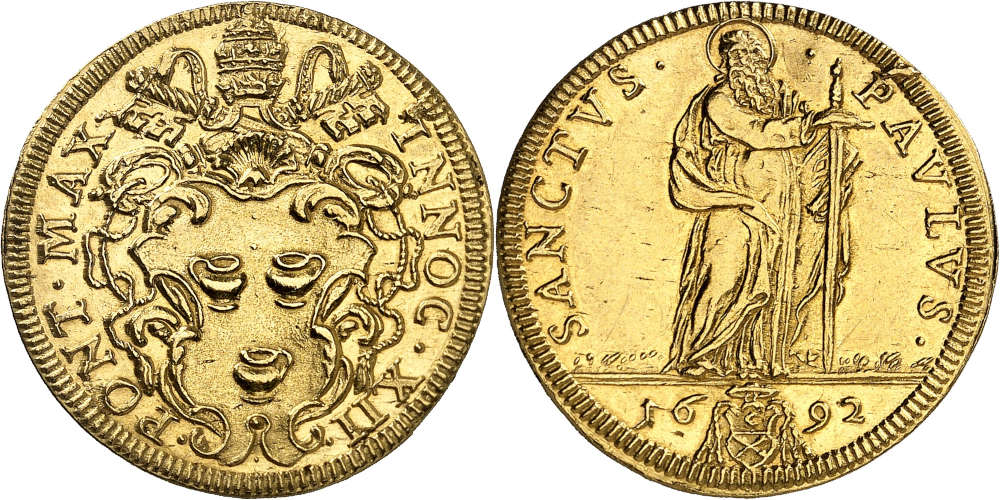
No. 1454. Innocent XII. 1692 doppia, Rome. Very rare. Extremely fine. Estimate: 7,500 euros. Hammer price: 22,000 euros.
3rd Place:
As many as two lots jumped from an estimate of 7,500 euros to a hammer price of 22,000 euros: first a very rare and extremely fine doppia, issued in 1692 on behalf of Innocent XII. The piece depicts his coat of arms on the obverse and St. Paul on the reverse.

No. 1540. Sede vacante 1721. 1721 scudo d’oro, Rome. Very rare. Extremely fine to FDC. Estimate: 7,500 euros. Hammer price: 22,000 euros.
The second piece is a scudo d’oro created in 1721. It was minted during the 38-day sede vacante period between the death of Pope Clement XI and the election of Innocent XIII. It was issued on behalf of Cardinal Annibale Albani, whose coat of arms can be seen on the obverse. He held the office of Camerlegno (= cardinal treasurer), which is why he organized the papal conclave and was responsible for the administration of the Holy See during the sede vacante. He owed this office to his uncle, Pope Clement XI. Modern historians refer to this type of career assistance as ‘nepotism’, derived from the word ‘nepos’ (= nephew, descendant). This is why some of us today might question the truthfulness of the message on the reverse of this coin. It shows the Holy Spirit, which – according to Catholic tradition – inspires the papal election at the conclave.
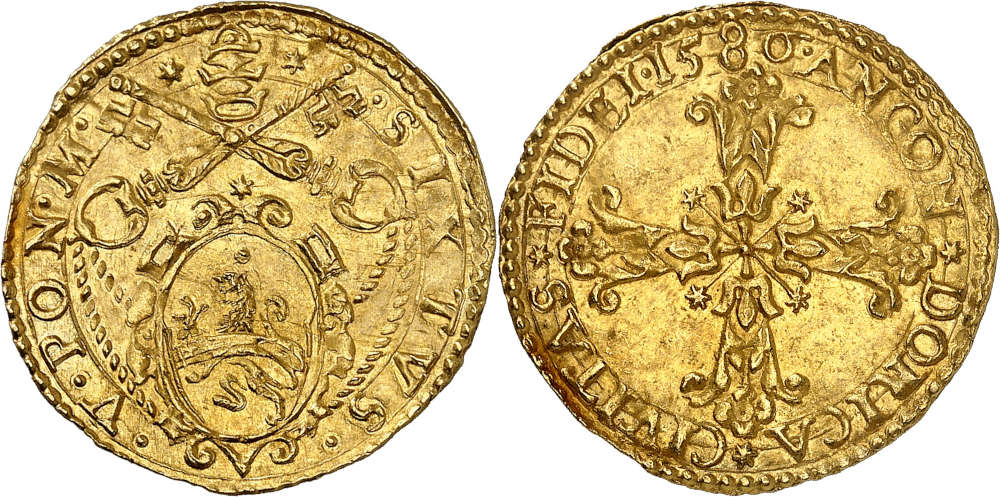
No. 1340. Sixtus V, 1585-1590. 1586 scudo d’oro, Ancona. Very rare. Extremely fine. Estimate: 10,000 euros. Hammer price: 24,000 euros.
2nd Place:
With a result of 24,000 euros and an estimate of 10,000 euros, in second place we have a very rare 1586 gold coin minted in Ancona. It bears the name of Sixtus V. He was one of the most influential popes in ecclesiastical history. Just how active he was in shaping church life is illustrated by the large number of initiatives he put forward in 1586, the very year this coin was minted:
- He limited the number of cardinals to 70 in order to make the conclave more effective and the papal election faster.
- He had the obelisk erected in St. Peter’s Square, which required 900 workers and 75 horses.
- He also had three courtesans hanged because he wanted to prevent the many clergymen who broke their vows of celibacy from sinning.
Papal history certainly is made up of brighter and darker chapters. Just like all epochs in human history.
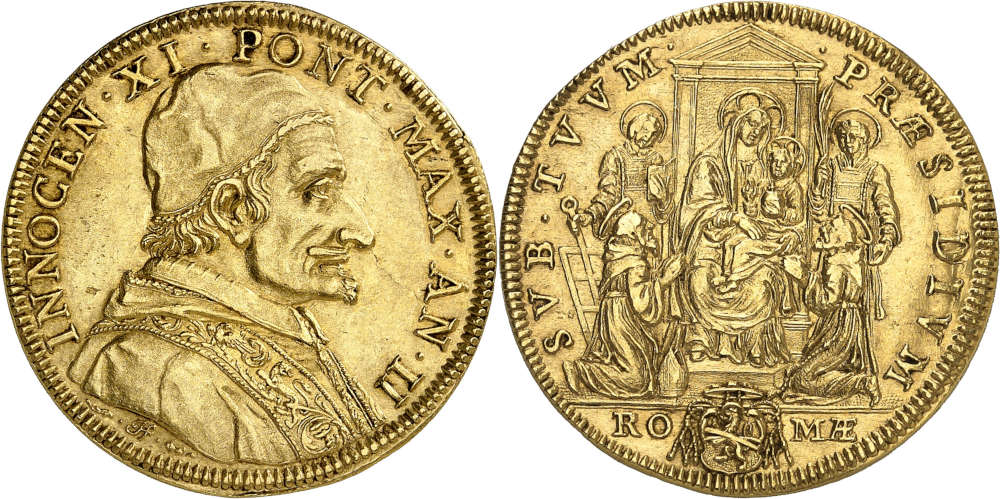
No. 1403. Innocent XI, 1676-1689. Quadrupla AN II (1676/77), Rome. Very rare. Extremely fine. Estimate: 30,000 euros. Hammer price: 38,000 euros.
1st Place:
The most expensive piece of the auction fetched 38,000 euros and was a quadrupla from 1676/7. It depicts a splendid portrait of Pope Innocent XI. The dies were created by Giovanni Hamerani (1646-1705), son of Alberto Hamerani, the first craftsman from the Hamerani family who specialized in medal production. Giovanni taught his craft to his three children, including his daughter(!). Even his great-grandson of the same name still worked for the papal mint and re-struck particularly popular medals using the dies he inherited from his ancestors.
Catalog 404: Mainz Coins and Medals from the Pick Collection – Part II
Let us move on to the next catalog with Mainz coins and medals of the Pick Collection. Collectors do not simply stop collection just because they sold their collection. That is why Prof. Dr. Eckhart Pick immediately started his second collection after the sale of his first Mainz collection in 2011. This time, he focused on all fields of Mainz numismatics that had been missing in his first collection. It is impressive to see how many very rare pieces Prof. Dr. Pick assembled in such a short time. We present the three most expensive lots.
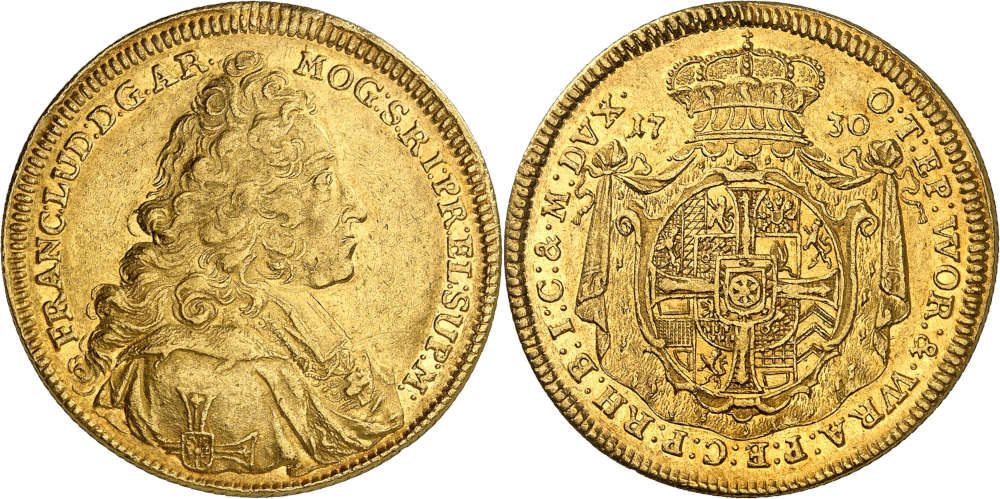
No. 2471. Franz Ludwig von Neuburg. 6 ducats 1730, unsigned, Vienna. Extremely rare. Very fine to extremely fine. Estimate: 35,000 euros. Hammer price: 28,000 euros.
3rd Place:
28,000 euros was the hammer price for the 1730 6-fold ducat minted on behalf of Franz Ludwig von Neuburg in Vienna. Since such heavy gold coins were not intended for normal payment purposes but as diplomatic gifts, one may well wonder why the Mainz archbishop needed such coins. To understand this, we must take a look at his family situation: At the time of minting, his brother was the Elector of the Palatinate, another brother of his was Prince-Bishop of Augsburg; through his sister, he was the uncle of the Emperor, the uncle of the King of Portugal, the great-uncle of the King of Spain, and the brother of the widow of the last Spanish king from the House of Habsburg. Thus, Franz Ludwig von Neuburg certainly had enough occasions to use coins as diplomatic gifts.

No. 2313. Georg Friedrich von Greiffenklau zu Vollraths. 1629 broad double reichstaler, Mainz. Very rare. About extremely fine. Estimate: 20,000 euros. Hammer price: 30,000 euros.
2nd Place:
Another piece that was probably created for diplomatic purposes is this broad double reichstaler of 1629, which became the second most expensive coin of the Pick Collection with a hammer price of 30,000 euros. The year of its creation might give us a clue as to the context of this specimen. It was minted in 1629, in the middle of the Thirty Years’ War, and in the very year that Emperor Ferdinand II issued the Edict of Restitution. The man who had this double taler issued had played a decisive role in this process. The Edict of Restitution aimed to reverse the expropriations by means of which the imperial cities and imperial princes had seized church property in previous years. Just like the emperor, Georg Friedrich von Greiffenklau zu Vollrath was a Catholic hardliner who did not want to accept that the property of two archbishoprics, seven bishoprics and more than 500 monasteries was no longer in Catholic hands but in secular ones. This imperial taler might have been minted to propagate this cause and the Edict of Restitution. If this was the case, he failed miserably. The imperial order infuriated the Protestant estates to such an extent that they supported the invasion of the Swedish ruler Gustav II Adolf.
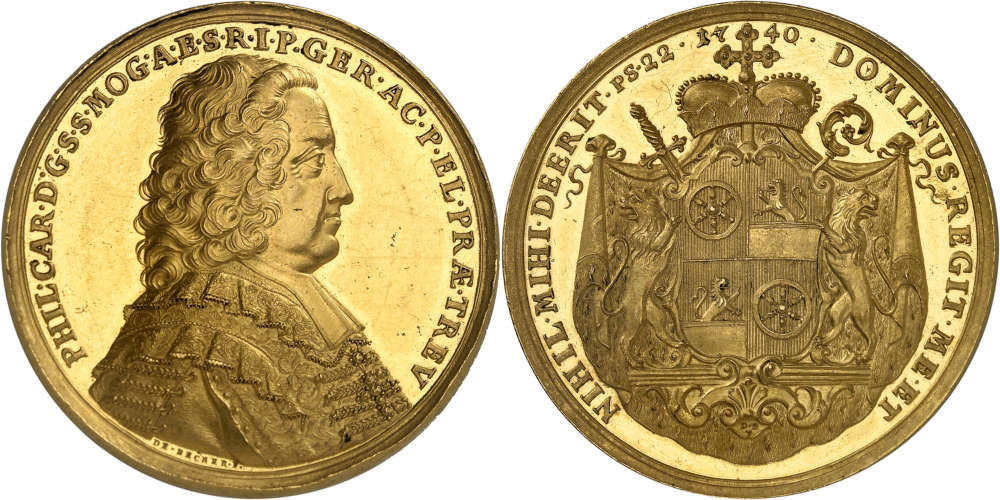
No. 2474. Philipp Karl von Eltz-Kempenich. Gold medal of 25 ducats, 1740. Extremely rare. Extremely fine to FDC. Estimate: 75,000 euros. Hammer price: 70,000 euros.
1st Place:
In first place of the second part of the Pick Collection we have a gold medal of 25 ducats from 1740 with a hammer price of 70,000 euros. It is extremely rare, particularly in this quality – NGC graded the piece MS 63*PL. The collector acquired the rarity as recently as in March 2021 from the Paramount Collection.
Catalog 405: Regensburg
On the third day of the auction week, an important special collection of Regensburg issues was sold. Regensburg talers and ducats are highly popular because Regensburg was the venue of the Perpetual Diet and therefore produced particularly attractive coins. Detailed city views created by the best engravers of their time – that is typical of Regensburg coinage. And once again, collectors were amazed by the 321 lots and doubled the total estimate. We present the three most expensive pieces, which, by the way, are also exclusively gold coins although the collection contained numerous attractive and highly rare talers.
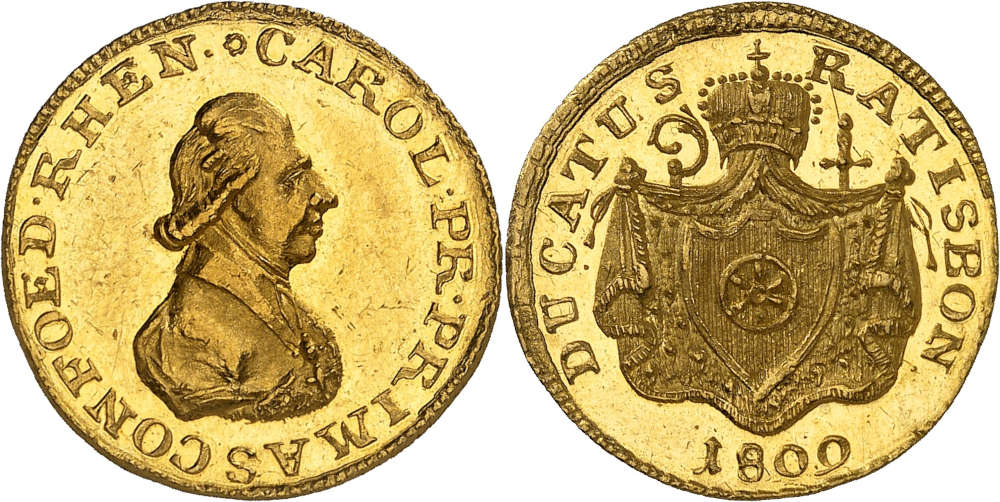
No. 3320. Principality of Regensburg. Carl Theodor von Dalberg, 1804-1810. 1809 ducat. Very rare. Extremely fine. Estimate: 20,000 euros. Hammer price: 30,000 euros.
3rd Place:
30,000 euros were achieved by the 1809 ducat that is among the great rarities of Regensburg numismatics. It is from the time when Napoleon determined the fate of German states. After the Final Recess of the Imperial Deputation (Reichsdeputationshauptschluss), Napoleon created a new dominion for his loyal supporter Carl Theodor von Dalberg, the former Archbishop and Elector of Mainz: Dalberg was the only ecclesiastical prince in the empire who was still allowed to exercise secular power, albeit no longer in Mainz – which had largely fallen to France – but in Regensburg and Aschaffenburg. In this position, he retained his offices as Imperial Archchancellor and Prince Primate. Between 1806 and 1813, von Dalberg even assumed presidency over the Confederation of the Rhine. After the defeat of Napoleon, he was left with the ecclesiastical office of Archbishop of Regensburg.
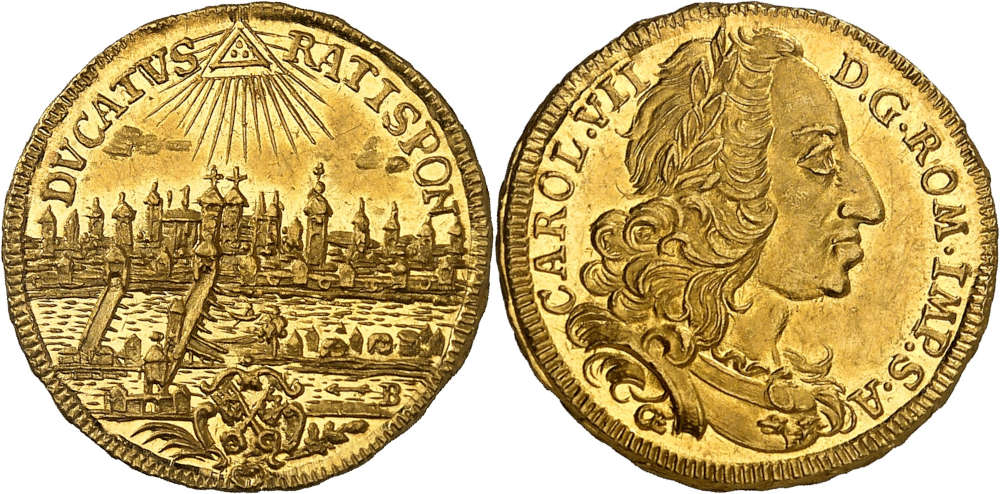
No. 3209. Regensburg. 2 ducats n.d. (1742). Very rare. NGC MS62. Extremely fine to FDC. Estimate: 10,000 euros. Hammer price: 36,000 euros.
2nd Place:
36,000 euros were fetched by the second most expensive coin in the collection. It was created in 1742 and commemorates the election of Charles VII from the House of Wittelsbach as emperor. He was elected during the War of the Austrian Succession, a move that was clearly directed against Maria Theresa. We can see the portrait of the new emperor on this very rare, undated double ducat. His election had terrible consequences for the citizens of Regensburg: Charles VII moved the Perpetual Diet to Frankfurt am Main. This was a bitter loss, as Regensburg owed its prosperity in large parts to the many international envoys who resided there. Therefore, they probably were not very sad when Charles VII died as early as on 20 January 1756 and Francis I of Lorraine brought the Perpetual Diet back to Regensburg immediately after being elected.
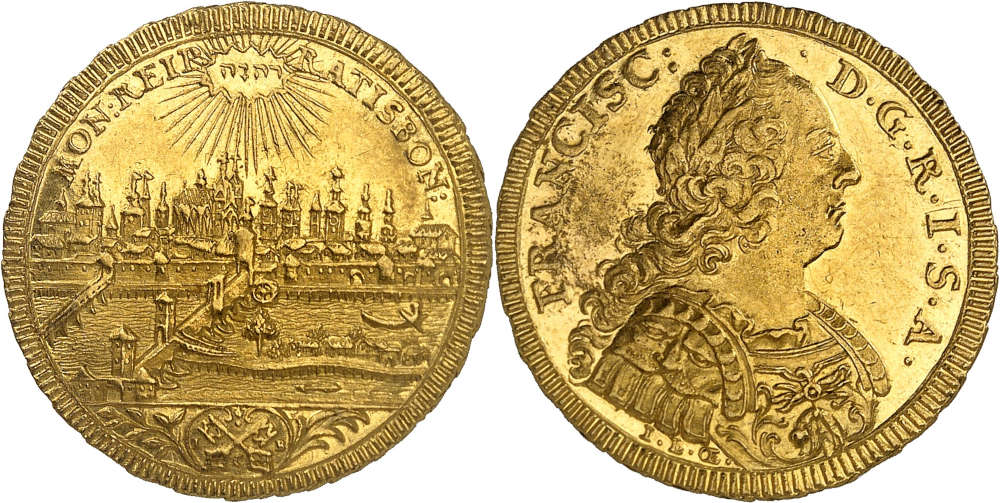
No. 3229. Regensburg 2 ducats n.d. (1745-1765). Extremely rare. NGC MS62. Extremely fine +. Estimate: 10,000 euros. Hammer price: 55,000 euros.
1st Place:
The portrait of the new emperor Francis I of Lorraine is depicted by the most expensive coin of the collection. It jumped from an estimate of 10,000 euros to a hammer price of 55,000 euros. The piece was produced with the dies of the 1/8th-taler and presents a wonderful city view, with the Old Bridge, which still exists today, at the center. We can clearly see the city walls, the cathedral, St. Emmeram and Niedermünster as well as a mill wheel to the right of the Old Bridge. It represents the many mills that Regensburg citizens had been operating along the Old Bridge since the 15th century. They were not only used to mill flour but also to create broad cloth, sharpen knives and swords, to crush pulp for paper production and many other early modern trades. The extremely fine condition of the piece, which was graded MS62 by NGC, allows us to admire and interpret every single detail of the city view.
Auction 406: Issues from Medieval and Modern Times
The last public auction of Künker’s spring auction week lasted two and a half days. Catalog 406 contained more than 1,800 lots with world coins and medals, of which we present only the three most expensive individual pieces. We have to emphasize that these are individual issued because the second most expensive lot in the auction sale – which is not presented here – was not an individual piece but a multiple lot of 14 specimens. Künker did not want to tear apart an impressive collection of 100-franc coins of Napoleon III, even though one of them was one of the rarest coins of the Latin Monetary Union: the 100-franc piece from 1870, minted in Paris. Actually, these coins had not been rare to begin with. But the French government sent many of them to Berlin as reparations after the Franco-Prussian War, where they were melted down. During the first years of the German Empire, its gold coins were minted from these melted down pieces. The entire collection was estimated at 100,000 euros and sold for 165,000 euros.
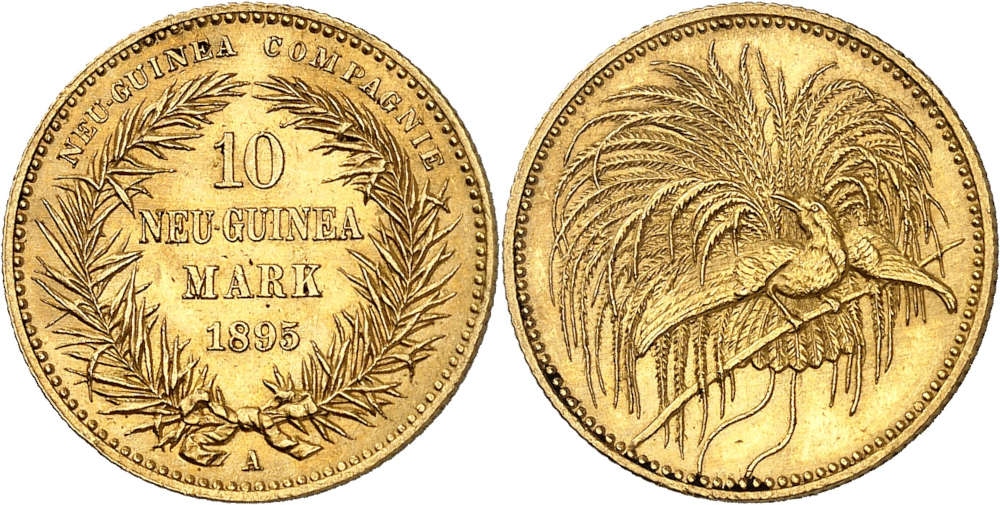
No. 5172: German New Guinea. 10 New Guinean marks 1895. Only 2000 specimens minted. NGC MS65. Extremely fine to FDC. Estimate: 40,000 euros. Hammer price: 62,500 euros.
3rd Place:
62,500 euros was the hammer price for the third most expensive coin from auction 406, which was minted in Berlin with a mintage figure of only 2,000 specimens on behalf of the New Guinea Company. However, the aesthetically pleasing pieces never saw the country they had been intended for. They ended up in the collections of German coin collectors instead. These collectors were delighted by the marvelous depiction of a bird of paradise, unaware of the fact that stuffed bird pelts – probably the island’s most profitable export item at the time – had already been used as currency by the indigenous peoples of New Guinea for centuries.

No. 4144: Brunswick and Lüneburg. Julius. 1574 löser of 10 reichstalers, Heinrichstadt (Wolfenbüttel). Extremely rare. Extremely fine. Estimate: 75,000 euros. Hammer price: 95,000 euros.
2nd Place:
The magnificent issues of Duke Julius of Brunswick-Wolfenbüttel are referred to as Juliuslöser. They were his attempt at imitating the success of the north German portugalöser – a heavy gold coin that was readily used for international trade. Since Brunswick had large silver reserves, Julius created a heavy silver coin. In this way, he could reduce minting costs and significantly increase the seigniorage. The lösers were issued in various denominations. Our example, which jumped from an estimate of 75,000 euros to a hammer price of 95,000, making it the second most expensive individual piece of auction 406, actually has a face value of 10 reichstalers. The X can clearly be seen on the reverse in the orb of the central field. But if you weigh the coin, its weight corresponds only to 9 reichstalers. Thus, in addition to the seigniorage, Julius secured an additional agio of 10%.
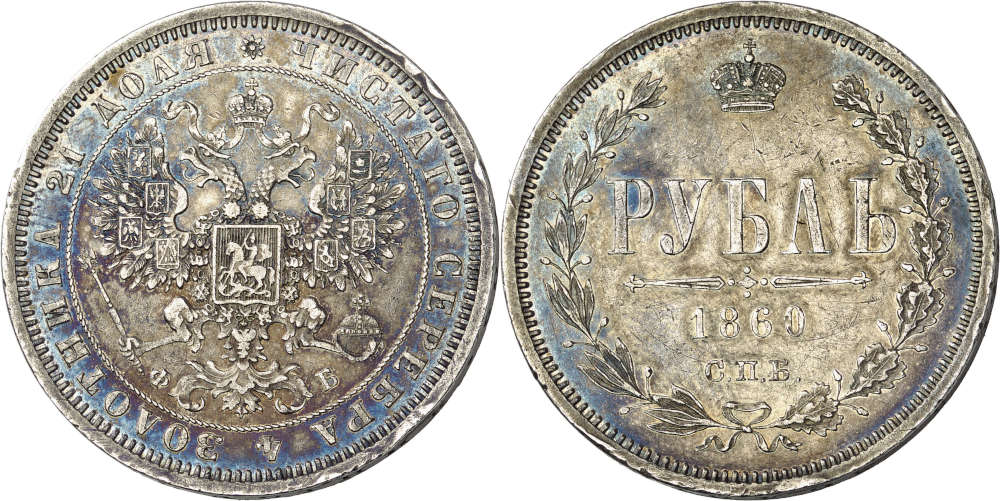
No. 4815. Russia. Alexander II / Pattern of the 1860 ruble, St. Petersburg. Extremely rare. About extremely fine. Estimate: 50,000 euros. Hammer price: 170,000 euros.
1st Place:
A rarity of outstanding quality combined with an unparalleled patina: these characteristics catapulted the pattern for the Russian 1860 ruble, minted in St. Petersburg to the top of the entire auction week. The coin had an estimate of 50,000 euros and was sold as the most expensive piece of the entire auction at 170,000 euros.
Even though only very few people can afford to buy a coin in this price segment, Künker’s auctions 403 to 406 presented many pieces which were sold in the medium two-digit range. Everyone can afford to collect coins. So please do not be intimidated by the selection of the pieces in this review! Look for yourself and you will see that the auction also featured fascinating coins and medals in your price range!




